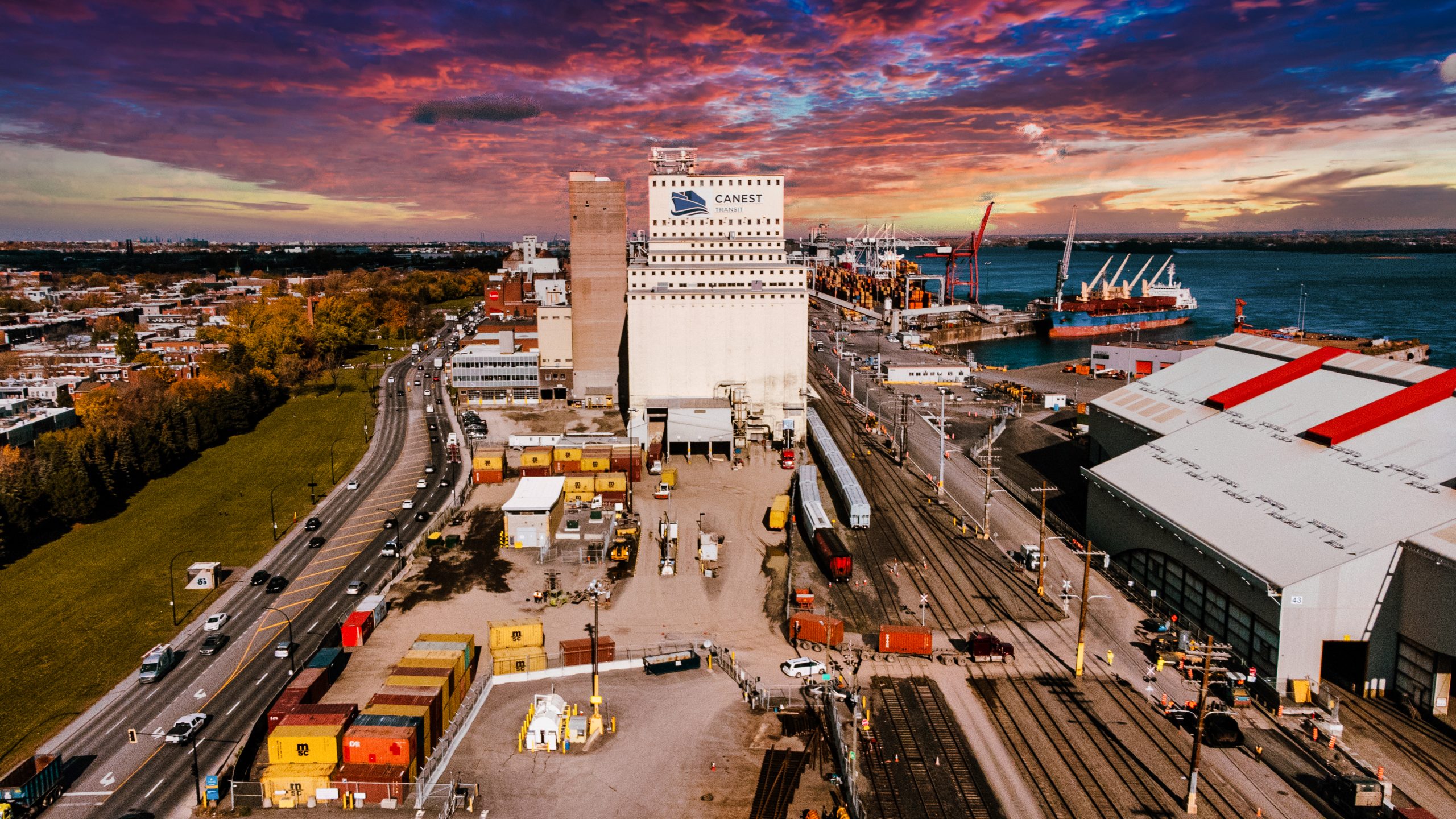By Julie Gedeon
Great Lakes and St. Lawrence ports are bustling this spring to deliver the last of 2022’s strong harvests. And at the same time, infrastructure and technology investments are increasing capacity in the region’s ports to meet rising world demand for agri-food products.
“Thanks to the marine highway’s resilience, grain exports were just slightly down last year due to global economic and geopolitical challenges that affected trade movement in some cases,” says Terence Bowles, President and CEO of the St. Lawrence Seaway Management Corporation (SLSMC). “We’re expecting last year’s grain carryover to generate some strong commercial opportunities for producers this year.”
Grain transits through the Eastern corridor are up approximately 20 per cent. The increase is partly in response to Russia’s invasion disrupting Ukraine’s grain distribution, but also a result of producers and shippers seeking to diversify their export markets and routes, given the supply chain bottlenecks on the West Coast as well as ongoing tensions with China.
“Our system’s ease of use and reliability were clearly proven during the pandemic,” Mr. Bowles says, adding that continual efforts to improve efficiencies and reduce greenhouse gas emissions are likewise being noticed worldwide.
While improving safety, hands-free mooring has also sped up lock transits by up to 10 per cent.
Another example is draught readings that allow ships to load more cargo to a safe limit, making each journey more economically and environmentally advantageous.
“The Seaway is already in constant communication with each ship through AIS tracking but we’re now working on implementing a digital tool called Voyage Information System,” Mr. Bowles adds. “It will help us to know when each ship is set to arrive or depart to facilitate a better planning of transits and resources that will generate economic and environmental benefits for the Seaway and its users.”
With agricultural producers using science and technology to increase crop yields, there’s great opportunity to augment grain traffic. “Even a minor percentage increase in annual harvests gives us a lot of additional grain to ship,” Mr. Bowles notes.
U.S. ports are expected to introduce 500,000 tonnes of new grain capacity to the system with brand-new expanded facilities at the ports of Milwaukee and Duluth. “U.S. grain has primarily been shipped to China, but producers are seeking to diversify their customer base within the European market which favours the Eastern corridor,” Bruce Hodgson, SLSMC’s Director, Marketing, explains.
Demand is robust, spanning from the United Kingdom, into Western Europe, all the way to the Middle East.
The Seaway has already been working with various stakeholders to support the development of new or expanded grain-handling facilities. On the Welland Canal, London Agricultural Commodities has purchased the Ceres Global Ag’s Port Colborne terminal (the former Robin Hood flour mill) for US$4 million.
“We expect this grain shipper to handle approximately 12 vessel loads to Europe this year,” Mr. Hodgson says. “The calls that the Spliethoff line makes at the Port of Valleyfield and Port Colborne on the way to and from Cleveland as part of its trans-Atlantic route are paying off.”
Expanding CanEst facilities at Montreal
At the Port of Montreal, CanEst Transit Inc. is undertaking an $18-million expansion that will double its capacity to 35,000 containers upon completion, which is slated for June 2025.
Approximately $8 million is being funded by Transport Canada through the National Trade Corridors Fund.
“We’re now at our maximum capacity even though we’ve increased our annual handling volume from 7,000 to 15,000 containers over the past three years,” says Marc-Aurel Clapperton, CanEst’s General Manager.
The expansion project has six major components with some already under way and each geared toward increasing capacity, efficiency, as well as broadening the range of grain services. “Most everything used to be delivered in bulk,” Mr. Clapperton explains, “but now we’re seeing more demand for bag-to-bag exports, fine grain cleaning, as well as 40-foot container shipments – all of which we’ll be able to do.”
Improvements in rolling stock, loading equipment, along with traffic flow optimization within the railyard, are expected to increase capacity by 5,000 additional containers in 2023. “We’ve already spent $2 million on reach stackers to create a higher loading station for the 40-foot containers,” Mr. Clapperton notes.
Vietnam, Indonesia, Turkey and Egypt are some of CanEst’s newer export markets, while China is increasingly having grain shipped from the Port of Montreal to avoid the possible bottleneck delays experienced on the West Coast. “Throughout the pandemic, the Port of Montreal has proven to be more resilient and balanced in its trading operations,” Mr. Clapperton notes.
A major challenge to maintaining that balance is finding sufficient employees. “We started CanEst with 25 people three years ago, and now we’re at 130,” Mr. Clapperton says. “We’ll need to fill another 50 positions for this expansion, so our Human Resources department is constantly on social media platforms and encouraging our current workforce to tell others about these good permanent jobs.”
Record year at Hamilton
At the Port of Hamilton, agri-food commodities are stronger than ever where they accounted for one-third of the 9.8 million tonnes of cargo in 2022. “The port handled more than one million tonnes of soybeans and 1.5 million tonnes of wheat and corn, along with 85,000 tonnes of raw sugar for refining and use by regional food processors,” says Ian Hamilton, the President and CEO of the Hamilton Oshawa Port Authority (HOPA)
He credits the large investments by agri-food producers Richardson International, Parrish & Heimbecker, and G3, as well as $32 million in port expansion upgrades whose costs are being roughly split by HOPA and the National Trade Corridors Funds, for the second biggest year in terms of agri-food volumes in the port’s history in 2022. “Compared to the five-year average, we’re up about 33 per cent,” he adds.
Private investment has been substantial with Parrish & Heimbecker and Sucro Sourcing, for example, putting $150 million at Pier 10 to build a new grain terminal, flour mill, and sugar refinery and crystallization facility in recent years.
HOPA is now turning its attention to expanding capacity and improving efficiencies at the Port of Oshawa where the National Trade Corridors Fund is providing $14 million of a $35-million export expansion project.
“We have opportunity to better service the Durham region’s farmers through expansion,” Mr. Hamilton says. “So, we’re building a second terminal with the capacity to hold a full vessel’s load of grain inventory, as well as improving the roads in and out of the port it’s faster to drop off grain and leave the port.”
Once the new terminal is working at capacity, it is expected to avoid up to 10,000 trips across the GTHA region annually for Durham region farmers, reducing road congestion and preventing 5,000 tonnes of carbon emissions annually. By making greater use of the Port of Oshawa, the Port of Hamilton will also increase its capacity to serve customers in closer proximity to its location.
Mr. Hamilton says the expansions are needed to accommodate the increasing world demand plus the not unexpected five to six per cent overall growth in Ontario crop yields over the next decade as a result of smart and precision farming techniques and improved fertilizers, regardless of any possibly unfavourable weather years.
“We have a CAPEX plan to invest $55 million in all of our infrastructure projects in 2023 – our biggest year ever, but we’ve also been dealing with both the inflationary rise in the costs of materials, as well as a shortage of trades people,” Mr. Hamilton says.
“Game-changer” at Windsor
ADM’s operations already give Port Windsor the largest grain-crushing facility on the Great Lakes, providing canola and other grain-based oils to numerous consumers. Now Port Windsor has its sights set on a new $30-million project at an adjacent terminal to be able to containerize more crops for export.
Port Windsor is aggressively pursuing the project with the hopes of having approximately half of the costs paid through the National Trade Corridors Fund. It will encompass a new 23.8- hecatre (70-acre) hard-top dock area with storage and security fencing and lighting. A crane has already been acquired with the goal of launching this container operations within the next year or two.
The agri-food market opportunities abroad open up significantly with containerization, Mr. Salmons explains, because a number of foreign ports aren’t designed to handle bulk goods but can readily transfer containers onto railcars or trucks.
“Being able to get more containers to our customers is a game-changer,” Mr. Salmons emphasizes. “Just as minor coastal ports turned into significant trade hubs with shortsea shipping, so will municipalities that can handle containers see their local industries and economies strengthen with this competitive edge – there’s no doubt in my mind.”
(Photo of CanEst operations at Port of Montreal)








